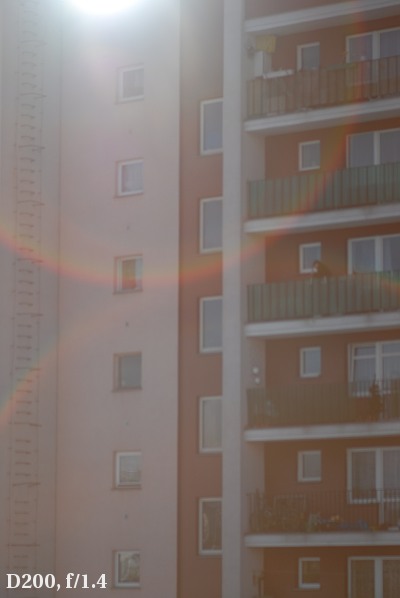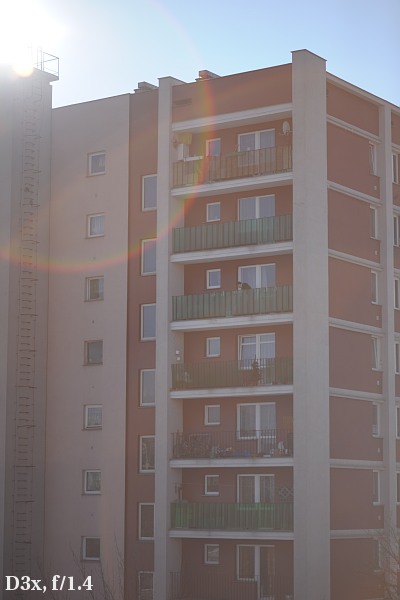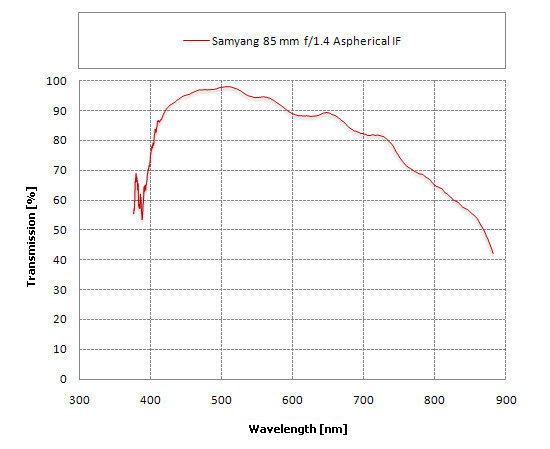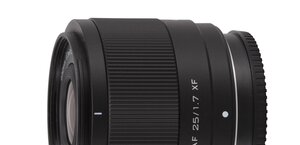Samyang 85 mm f/1.4 Aspherical IF
9. Ghosting, flares and transmission
 |
 |
Please Support UsIf you enjoy our reviews and articles, and you want us to continue our work please, support our website by donating through PayPal. The funds are going to be used for paying our editorial team, renting servers, and equipping our testing studio; only that way we will be able to continue providing you interesting content for free. |
- - - - - - - - - - - - - - - - - - - - - - - - - - - - - - - - - - - - - - - - - - - - - - - -
In the 1940s anti-reflection coatings were used for the first time as a means of minimising light reflection at the air-to-glass surface, and thus making the transmission high as well as avoiding undesired flares. Initially, a single-layer coating was used based mainly on magnesium fluoride, and this was able to reduce light reflection on one air-to-glass surface from about 5% to just under 1.5%. In the early ‘70s, several independent firms virtually simultaneously began using multi-layer coatings. It was then that we saw in action the Pentax SMC layers, the famed Zeiss T* coatings, the Canon SSC and Nikon SIC. For many years it was the quality of coatings that distinguished high class equipment from cheap immitations. Applying a multilayer coating , different for each surface and combined in such a way that the resulting transmission graph was as flat and high as possible, demanded advanced technology, which only the biggest players could afford. The leading firms perfected the layers to such a degree, that at one surface in the wide range of the visible spectrum, they reflected barely 0.2% light and the drove the transmission level of the whole instrument up to a level of 95% or even higher.
Bearing this in mind, what can we expect from the Samyang? With 7 groups it is necessary to apply a coating to 14 air-glass surfaces. If the manufacturer had decided to apply a standard fluoride coating optimised for the centre of the visible spectrum, we could count on a maximum transmission for wave lengths 550-600 nm and reaching 81-83%.
But in reality? Let’s look at the graph below which shows the transmission of Samyang with the help of a photo-spectrometre.
 |
In all honesty, I am still rubbing my eyes in amazement, as the graph looks really good. Above all, the lens behaves very well in the blue band. Transmission exceeds 90% even at 420 nm, which is rarely witnessed. When we come to the centre of the spectrum, its even better. In the region of 500nm, transmission reaches an amazing 98%! What does this mean? It is telling us that at one air-to-glass surface, the cheap Korean-made Samyang, looses barely 0.2% light! Cosmic technology comes within reach. Something which only not long ago was available from the elite and for big money, has now been handed to us in the cheapest lens.
I want to find some hole to pick, it all looks too rosy. But what to do when there is none? From around 550 nm transmission levels fall, but not rapidly and at 600 nm still maintains 90%. At the edge of the spectrum, at around 700 nm, we still observe a high level of 82%. Three cheers!
For the unrelenting, the hole to pick might be the appearance of flares. Transmission isn’t the be all and end all - it’s necessary to deal with the light which reflects from the surfaces and travels up the lens leading to undesired effects. I think that with time, Samyang will learn how to construct the body of the lens to minimise the appearance of these flares.






